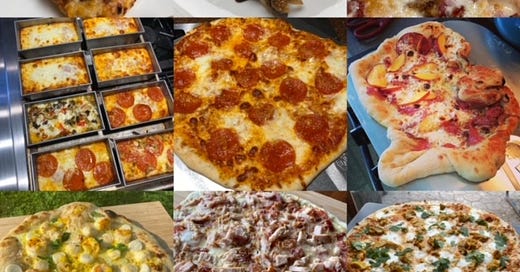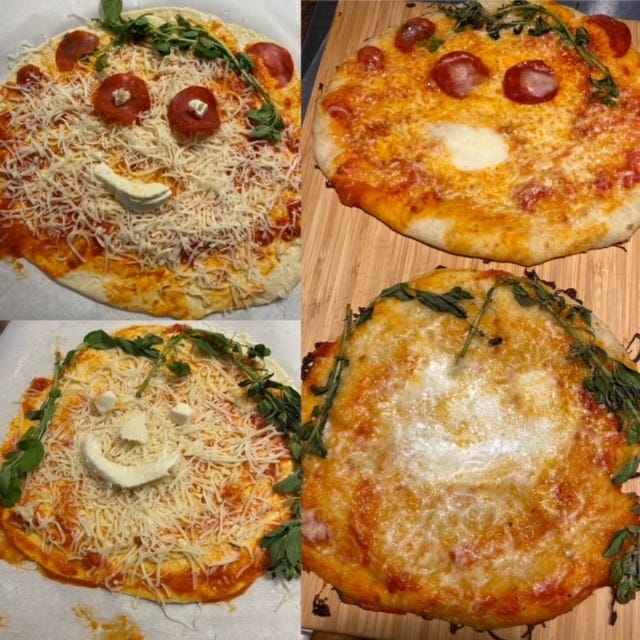Every time I make a pizza at home, I text a picture of it to one particular friend.
Texting pictures of my food to friends isn’t unusual behavior for me, of course; I do it all the time, snapping photos of things I’ve made for dinner or gotten at a restaurant. Heck, I even have a long-running and cherished group text that’s dedicated, at least in name, to the practice. (Shout out to the FoodBros.)
This text is different, though, because it’s purely antagonistic.
You see, this friend and I share very different philosophies on pizza.
He’s a pizza purist, a believer in a very simple, straightforward and elemental definition of the food: dough, sauce, cheese, and maybe pepperoni or sausage. It’s the Strict Constructionist theory of pizza; if it wasn’t widely available on a pizza in 1981, then it shouldn’t be on a pizza now. Imagine the John Birch Society, except with Chuck E. Cheese as its namesake martyr instead.
Me? I’m a pizza activist.
I believe in a broad and expansive definition of pizza, one that allows for continual innovation, adaptation and reinterpretation to fit our modern context. In my pizza theory, as long as I can put it on a circle of dough and bake it, then anything goes. Sure, I love a classic pepperoni-and-cheese pie as much as anyone—and I’ll occasionally text him one of those, too, just to prove that I’m capable of it—but I like to get a little wild with it.
Sometimes it works. Sometimes it doesn’t.
Here’s just a small selections of things I’ve deigned to call pizza, including (from left to right, then top to bottom, linked if they’re something I’ve shared here):
School Cafeteria-Style “Mexican” Pizza (this was very good)
Fig, caramelized onion, bacon, blue cheese and arugula pizza (excellent)
BBQ pizza made with leftover pulled pork (perfectly fine, as I recall)
Miniature Detroit pizzas (can’t go wrong, and didn’t)
Pepperoni Pizza (it’s pepperoni pizza)
I think this was peach and prosciutto? I made this one like seven years ago. The idea was decent, the execution was not. I had not mastered the art of sliding the pizza off the peel into the oven, and it shows in the abstract-expressionist shape.
Billionaire’s Pizza (it was a fun idea executed well but I don’t need to do it again)
Kentucky Hot Brown Pizza (excellent)
Chicken Tikka Masala Pizza (excellent)
There have even been a few so fantastically ill-conceived that I don’t seem to have photos saved of them anymore, like the time many years ago that I got the notion to make a “fall flavors” pizza, one with chunks of roasted turkey, thinly-sliced apples, cheddar cheese and a rye-flour-based pizza crust.
The idea sounded good, but the result was terrible, the rye flour making the crust so dense as to be practically inedible. It’s possible I could revisit the concept now with more pizza-making experience under my belt and get a better result, but there are times in life you learn to take the loss and walk away the first time, and this is one of those times. Never again.
Nevertheless, I persist on my pizza experimentation, much to the chagrin of this friend with whom I see eye-to-eye on most other things.
Of course, even if you’re not trying to be a mad scientist like me—or making your own pizza at all—everyone’s idea of pizza is different. New York Times food editor Sam Sifton famously conceived of what he calls the “Pizza Cognition Theory”, noting that “The first slice of pizza a child sees and tastes (and somehow appreciates on something more than a childlike, mmmgood, thanks-mom level), becomes, for him, pizza… He will defend this interpretation to the end of his life.”
I think about that definition and how it plays in my house, because for my kids, pizza means Domino’s. I am largely indifferent to the omnipresent chain’s pizza—it’s fine—but they sell medium pizzas for $5.99 and have a location with a drive-through a mile away from my house, and have thus become a large part of their Pizza Cognition.
They love it, they ask for it, and when my wife and I tell them “we’re having pizza tonight”, the vision that pops into their heads is Domino’s. So much so, in fact, that my seven-year-old’s current stated career aspiration is to be a “pizza maker at Domino’s”, and had my wife craft a costume to that end for him to wear to second grade Career Day.
(That does sound more fun than being an architect/blogger, to be fair.)
This weekend, I threw a curveball their way.
We would be having pizza, but we would not be going through the chain’s drive-through this weekend. We would be making our own pizzas; not just me, but all of us. I prepped four circles of dough. One, a Strict Constructionist pepperoni; another, an activist creation you’ll see here on Friday.
The third and fourth? Well, that was up to them.
I laid out some ingredients—sauce, fresh and shredded mozzarella, pepperoni, fresh herbs, etc.—and left their pies entirely up to their discretion.
Suddenly, it wasn’t just dinner, it was an art project.
White. A blank page or canvas. The challenge? Bring order to the whole through design, composition, tension, balance, light and harmony.
They quietly and diligently crafted their culinary masterworks, each choosing to make a face out of their pizza, with pepperonis for eyes, fresh mozzarella for mouths, and even sprigs of fresh oregano for hair. They beamed as their creations went into the oven, and squealed with delight as the distorted faces that came out a few minutes later.
They didn’t just admire the pizzas, though—they ate them with gusto, a rarity for home-crafted meals. There wasn’t any hesitation, any “Daddy, can we get Domino’s next time?” caveats. It’s a low bar to be sure, being thrilled that your kids enjoyed pizza, but they loved something we made from scratch, and for a pair of typical processed-food-loving American kids, I’m counting it as a victory.
So maybe I’ve got my own spin on Sifton’s theory: pizza is whatever you make it.
It’s a food that can be elevated to fine dining or sold for a dollar per slice out of a street-facing window. It can be no more than dough, sauce and cheese, or it can be a wild gourmet creation. It can be breakfast, lunch or dinner, or maybe even a slice snuck in in between meals. It’s there when you need it, and it’s pretty much everywhere when you do. It’s the perfect culinary playing field. Working with a small set of parameters—the size of the pie, the flavors, moisture and texture of the toppings, and the composition of them as a whole, there’s almost nothing you can’t do.
Just not the rye flour thing. That was a bad idea.
—Scott Hines (@actioncookbook)
Let’s talk pizza cognition. What’s your ideal pizza—either homemade or from a restaurant—and what do you think does or doesn’t belong on a pie?





I'm very glad this isn't a discussion of Chicago hotdish versus Detroit Square Pizza versus New York Greasy Pita etc.
I appreciate that pizza itself is very versatile, and I think it's fun to experiment with the core concept of the cheese delivery system.
1. pizza activist. the best pizza I ever had was at the fancy Italian restaurant on the Disney Fantasy. The waiter came out and asked us "do you-a mind if-a the chef sends you out a pizza?" and we were both like "what kind of question is that? of course!" he brought out a white pie with bleu cheese and grapes on it, and, hand to god, it was the best thing ever. more finely, I'm a toppings anarchist and a dough/sauce leftist, if only because I'm skeptical about whether or not Chicago style (delicious no doubt) is pizza or a doughy casserole.
2. My pizza cognition was always local joints because Philly is right in the southern girth of the Pizza Belt - https://www.gawker.com/the-pizza-belt-the-most-important-pizza-theory-youll-r-743629037